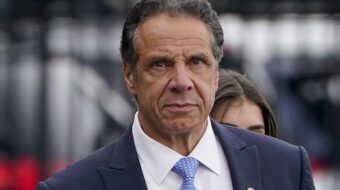
After almost nine decades, it’s clear there’s no stopping the country’s young communists
Over its 84-year history, the communist youth movement has taken part in and led some of the most important struggles of working-class youth — against poverty, unemployment and racism and for multiracial unity. It has fought for socialism in each generation, carrying the traditions of the working-class movement to young people, and enriching those traditions with the concerns and thinking of each new generation of youth.
• The first organizations of young communists in the U.S. were the Young Workers League (the youth section of the Workers Party) and the Young Communist League. Both were founded in 1922. The YWL campaigned against child labor, organized young workers into trade unions and engaged in solidarity campaigns against U.S. intervention in Nicaragua. It emphasized the growth of the new urban Black proletariat as a movement that was revolutionary itself. Special attention was also given to the 9 million African Americans in the South facing the daily threat of lynching. The YCL had a similar program, but because of government and employer repression, the YCL remained an underground group.
•In 1929, on the eve of the Great Depression, the YWL merged into the Young Communist League as a result of the reorganization of the Workers Party into the Communist Party. As the Depression deepened, the YCL, no longer banned, fought against youth unemployment and for free school lunches for the children of the unemployed. It joined in the struggle to free the Scottsboro defendants from legal lynching in Alabama.
• Working with the Communist-led Trade Union Unity League, the YCL began to organize industrial unions. Young Communists were active organizers and participants in the 1926 Passaic, N.J., textile strike, the 1929 Gastonia, N.C., textile strike, the National Miners Union strikes of 1928 and ’29, and the 1934 San Francisco waterfront general strike. Harry Simms, a 19-year-old YCL member, was assassinated in 1932 during efforts to organize the coal mines in rural Kentucky. The 1930s marked the largest growth of the YCL. The struggles to build the Congress of Industrial Organizations (CIO) in the auto, steel and other industries was a central activity for YCL members.
•As the danger of fascism became more apparent, the YCL turned its attention there. When the fascists launched a civil war to overthrow the democratic government of Spain in the 1930s, YCL members made up a large number of the 3,000 Abraham Lincoln Brigade volunteers who went to Spain to defend the republic. When WWII broke out, hundreds of YCL members volunteered and many gave their lives in the fight to defeat fascism.
•The YCL was involved in the revolutionary youth culture of this time. It was one of the first organizations to fight against the exclusion of Black players from professional baseball. It organized interracial dances and promoted jazz as an authentic working-class voice, rooted in the African American experience. In the 1930s, it held a swing concert, attended by 10,000 people, in New York’s Madison Square Garden.
• As World War II was raging in Europe, some Communists, influenced by Earl Browder, then general secretary of the Communist Party USA, came to believe the wartime unity of the Soviet Union and the United States would continue and that the class struggle had ended. Based on these theories, the Young Communist League was dissolved in 1943 and replaced by American Youth for Democracy. In 1944 Browder dissolved the Communist Party, replacing it with the Communist Political Association. The Communist Party was refounded in 1945.
The AYD campaigned for youth rights and struggled against racism, the Cold War and anticommunism, but it did not meet the needs of youth in the post-war era.
• In 1949 young Communists and other working-class youth formed the Labor Youth League, a Marxist-Leninist youth organization with fraternal relations with the Communist Party. At the height of anticommunist hysteria spurred by Sen. Joseph McCarthy, Paul Robeson addressed more than 5,000 youth at the LYL’s first national convention, Nov. 24, 1950. The revered singer, actor and political figure told the youth, “You are acting in the best tradition of the young generations which have preceded you at every critical moment of our history.”
During the worst days of McCarthyism, when Communists all over the country were being tried and convicted on trumped-up charges of “conspiring to overthrow the U.S. government,” the LYL did all it could to continue the tradition Robeson spoke of. Fighting for peace, racial equality and democracy won the LYL the attention of the Subversive Activities Control Board, which placed the LYL on its subversive organizations list in 1953.
With many LYL and Communist Party members in jail or losing their jobs, some felt that youth would not join a Marxist-Leninist organization and proposed establishing “socialist clubs.” The LYL fell apart and youth activists across the country started local independent radical youth organizations.
• The 1950s also marked the birth of the civil rights movement, with young people marching and sitting in. In the 1960s students across the country started demonstrating against the war in Vietnam. These new movements became turning points in the rebirth of a working-class youth and student movement.
In 1964, the W.E.B. Du Bois Clubs were formed, named after the champion of African American liberation who joined the CPUSA in 1961. The first mass youth demonstrations against the war in Vietnam were organized by the Du Bois Clubs. The Du Bois Clubs also were active participants and leaders in civil rights struggles.
The Du Bois Clubs were targeted by FBI Director J. Edgar Hoover’s Counter Intelligence Program (COINTELPRO), which also targeted the CPUSA, Dr. Martin Luther King Jr., Malcolm X, the Black Panther Party and other progressive fighters. The Du Bois Clubs were subjected to police attacks, infiltration and disruption. When the organization’s San Francisco headquarters was bombed in 1966, authorities never investigated the crime and no one was ever convicted.
• As the antiwar movement grew and conditions for youth worsened, an increasing number of youth believed socialism was the solution to the problems they faced and saw the central role of the working class in social change. In 1970, the Du Bois Clubs, other young radicals and youth members of the Communist Party founded the Young Workers Liberation League. It was based on several concepts: the need to unify all youth across racial and ethnic lines, and the strategy of organizing young workers around wages, job security and discrimination in the workplace and for peace, and relating these struggles to the working class and socialism.
Shortly after its founding the YWLL was invited by the Ho Chi Minh Working Youth Union to visit Vietnam to see areas destroyed by U.S. bombing and to exchange experiences with Vietnamese youth fighting for national liberation. The YWLL played a key role in the antiwar movement in the 1970s, emphasizing young workers’ interest in ending the war.
The YWLL also spearheaded the struggle for youth jobs at union wages, affirmative action and academic freedom. It helped to make the connection between jobs and peace, social needs and military spending, and racism and budget cuts. It organized among young workers, especially in basic industry.
The YWLL led solidarity campaigns for Chile’s Popular Unity government of Salvador Allende, elected in 1970. At a World Federation of Democratic Youth conference in Chile, the YWLL delegation was invited to a reception with President Allende, just weeks before he was murdered in the 1973 U.S.-backed coup. After the bloody overthrow, the YWLL played a leading role in organizing a movement to support the Chilean struggle against the Pinochet dictatorship.
• In 1983, as the Reagan administration cut more and more money from social programs and diverted it to the military to fight the “Evil Empire,” the YWLL reorganized itself into a new Young Communist League. With the new generation of youth and students no longer cowed by Cold War anticommunism, the times demanded the rebirth of the YCL and a new approach to organizing youth for peace, jobs and equality, the organizers felt.
The new YCL fought against campus budget cuts, union-busting and Reagan’s dirty wars in Latin America. The YCL was a key fighter against apartheid South Africa. It held sit-ins demanding that CPUSA leader and activist Angela Davis and CPUSA General Secretary Gus Hall be allowed to speak on campuses.
The YCL built voter registration coalitions and focused special attention on the oppression of working-class youth and especially youth of color, disproportionately hurt by cuts on social programs under Reagan and Bush I.
The YCL campaigned in the 1980s to defend affirmative action, abortion rights and gay and lesbian rights. In 1990-1991 the YCL opposed the first Gulf War and the genocidal effects of economic sanctions on the Iraqi people. The YCL was part of the “Battle in Seattle,” working to expose the anti-worker, anti-people, anti-youth policies of the International Monetary Fund and the World Bank.
In 2000 and 2004, YCL members fought to defeat George W. Bush and the ultra-right. The YCL played very important roles in local and national coalitions and in get-out-the-vote drives in Ohio, Missouri, Illinois, California, Texas, New York and across the country.
•Today, the YCL is in the forefront of the mass peace movement. It is a leading member of the National Youth and Student Peace Coalition and a steering committee member of United for Peace and Justice. The YCL and NYSPC have initiated annual “Books Not Bombs” campaigns on campuses nationwide. YCLers are active in the Student Labor Action Project supporting struggles of campus workers around the country, in the immigrant rights movement, and a host of other struggles. Its magazine Dynamic reflects the politics and culture of today’s youth movement.
In this time of anti-corporate upsurge and youth activism, the YCL is working with student, community, labor, environmental, LGBT and all peace and social justice groups and coalitions to build a broad youth and student movement.
Building on 84 years in the struggle, the YCL is looking ahead. The next 84 years are bound to be just as exciting, as it continues to struggle for equality, education, health care, union rights, voting rights, peace and socialism.
Tony Pecinovsky (tonypec@pww.org) is a member of the Young Communist League and is on the staff of the Missouri/Kansas Communist Party.









